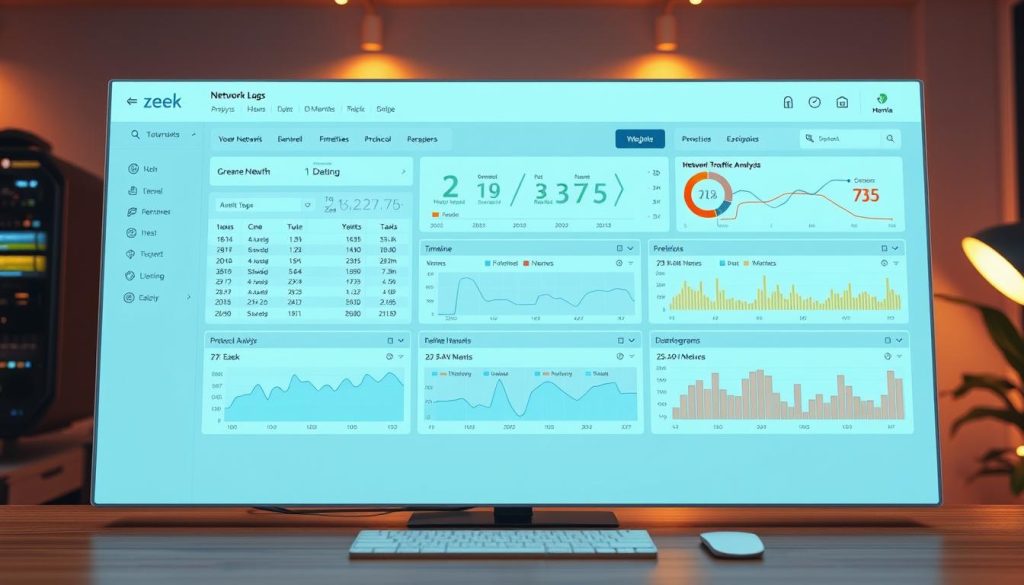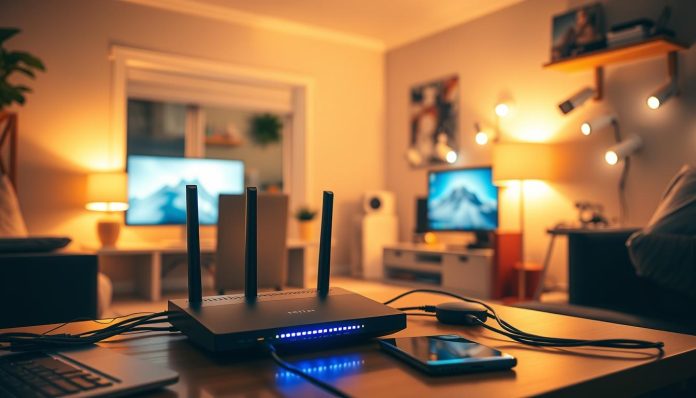Cyber threats are getting smarter, making it key to protect your home network. Using an intrusion detection and prevention system is a smart move. It boosts your home network protection.
Tools like Snort, Suricata, and Zeek are great options. They offer strong advanced cybersecurity without costing a lot.
These tools help strengthen your network against threats. This makes your online space safer for you and your family.
Key Takeaways
- Understand the importance of intrusion detection and prevention systems for home network security.
- Learn about open-source tools like Snort, Suricata, and Zeek.
- Discover how these tools can enhance your home network protection.
- Gain insights into the benefits of using open-source cybersecurity solutions.
- Find out how to implement these tools to secure your home network.
Understanding Intrusion Detection and Prevention Systems
Securing your home network is key, and knowing about Intrusion Detection and Prevention Systems (IDPS) is essential. These systems help spot and stop threats to your network.
What is IDS/IPS?
An Intrusion Detection System (IDS) watches your network for odd activity and warns you of threats. An Intrusion Prevention System (IPS) does the same but also blocks threats. Knowing the difference between IDS and IPS is important for strong network security.
Differences Between IDS and IPS
IDS and IPS differ mainly in how they handle threats. IDS just watches and warns, while IPS blocks threats. Here’s a quick look at their roles:
| Feature | IDS | IPS |
|---|---|---|
| Detection | Monitors network traffic | Monitors and analyzes traffic |
| Response | Alerts on suspicious activity | Blocks detected threats |
| Primary Function | Monitoring and alerting | Prevention and blocking |
Importance of Network Security at Home
Remote work and more devices at home make network security vital. Using an IDS/IPS can greatly improve your network’s safety. It keeps your data and devices safe from cyber threats.
By using IDS/IPS, you can actively protect your home network. This makes your digital space safer for you and your family.
Overview of Open-Source Solutions
Open-source IDS/IPS tools are a strong and flexible way to boost your home network’s security. They are affordable and can be tailored to fit your needs, making them popular among users.
Benefits of Using Open-Source Software
Using open-source IDS/IPS software has many benefits. The main one is the support from a large community. This community works together to improve the software, helping you stay safe.
Key benefits include:
- Flexibility and customizability to suit your specific security needs
- Cost-effectiveness, as most open-source tools are free to use
- Community support and continuous development
Popular Open-Source IDS/IPS Options
Some top open-source IDS/IPS solutions are Snort, Suricata, and Zeek. Each tool has its own strengths and features.
Let’s take a brief look at these options:
- Snort: Known for its rule-based detection system and extensive community support
- Suricata: Offers high-performance capabilities and is often used in large-scale environments
- Zeek: Provides a unique approach to network security by focusing on network traffic analysis

Choosing the right open-source IDS/IPS tool can greatly improve your home network’s security. Whether you choose Snort, Suricata, or Zeek, you’ll get powerful, community-driven solutions.
Introduction to Suricata
Suricata is a top-notch tool for keeping your home network safe. It’s an open-source IDS/IPS with strong security features. These features are both flexible and effective.
Key Features of Suricata
Suricata stands out for its ability to handle lots of network traffic at once. It does this through deep packet inspection. Here are some of its main features:
- Compatibility with Snort Rules: Suricata works well with Snort rules. This makes it a great choice for those who already use Snort.
- High Performance: It’s built to keep up with fast networks. This means your network’s speed won’t slow down.
- Advanced Detection Capabilities: Suricata can spot many different threats. It supports lots of protocols.

Installation Requirements for Suricata
Before you start, make sure your system can run Suricata. You’ll need:
| Component | Requirement |
|---|---|
| Operating System | Linux (various distributions supported) |
| Processor | Multi-core processor recommended |
| Memory | At least 4GB RAM, 8GB or more recommended |
Basic Configuration Steps
Setting up Suricata involves a few important steps:
- Initial Setup: First, install Suricata on your Linux system.
- Rule Configuration: Next, get and set up rule sets. Emerging Threats offers good ones.
- Network Interface Configuration: Then, tell Suricata which network interfaces to watch.
By following these steps, you can set up Suricata. It will help protect your home network from threats.
Working with Snort
Snort is a powerful tool for boosting your cybersecurity. It’s an open-source IDS/IPS system that spots known threats well. This makes it a great choice for keeping your network safe.
Snort Architecture and Features
Snort’s design lets you customize it for your security needs. It has some key features:
- Signature-based detection: It uses a database of known threats to find potential dangers.
- Protocol analysis: It checks network traffic for anything suspicious.
- Flexible rule system: You can make your own rules to fit your security needs.
Setting Up Snort on your Network
Setting up Snort takes a few steps. First, you need to download and install it. The steps to install vary based on your operating system.
After installing, you’ll need to configure Snort for your network. This includes setting up network interfaces, configuring the detection engine, and defining rule sets.

Customizing Snort Rules
Snort’s rule system is very flexible. You can make rules to catch specific traffic or ignore harmless activities. To do this, you need to know about network protocols and threats.
To make good custom rules, you must understand Snort’s rule syntax. This means knowing how to apply it to your security needs. You might need to create new rules or tweak old ones to avoid false alarms.
Learning to customize Snort rules can greatly improve your network’s security. It makes it harder for attackers to get past your defenses.
Exploring Zeek (formerly Bro)
Zeek, once known as Bro, is a top-notch tool for network security. It’s different from other systems that just block threats. Zeek dives deep into network traffic, logging everything it finds.
Zeek’s Unique Approach to Network Security
Zeek shines by analyzing network traffic in detail. It’s perfect for network security and digging into network crimes. It logs all network activity, giving you clues on security threats.
Zeek’s logs are super detailed. They help spot odd behavior, see how big a breach is, and meet reporting needs.
Installation and Initial Setup
To use Zeek, you need to install it on a system. It works on Linux and macOS. You can either compile it from scratch or use a package manager.
After installing, you’ll set up Zeek. You’ll tell it which network interfaces to watch and tweak settings for your needs.
- Find your network interface (like eth0 or en0).
- Adjust Zeek’s config files for monitoring.
- Start Zeek and start tracking your network.
Analyzing Traffic with Zeek
Once Zeek is up, you’ll see logs of your network. Use Zeek’s tools to check these logs for security issues.

Zeek can spot many security threats, like malware or unauthorized access. Regularly checking Zeek’s logs and using its tools boosts your network security.
Best Practices for Deployment
To keep your home network safe, it’s important to follow the right steps for IDS/IPS setup. You need to pick the right hardware, know your network layout, and set up the system for the best results.
Choosing the Right Hardware
The hardware you pick is key to your IDS/IPS’s success. Look for a system that can handle network traffic well without slowing down. A multi-core processor and enough RAM are essential for smooth operation.
Also, think about how much storage you need for logs and data. More storage means you can keep and analyze data for longer.
Network Topology Considerations
Knowing your network’s layout is crucial for setting up IDS/IPS. You should understand your network’s structure, including all devices and entry points. This helps place your IDS/IPS where it can best watch over your network.
Creating a network diagram can help you see your network’s layout. It can also show you where your network might be weak and guide your IDS/IPS setup.
Configuration Recommendations
Setting up your IDS/IPS right is key to its success. Begin by making it watch all important network traffic. You might need to use port mirroring or SPAN on your network switch to catch all traffic.
- Keep your IDS/IPS rules up to date to fight new threats.
- Adjust your system to cut down on false alarms, which can be annoying.
- Think about linking your IDS/IPS with other security tools, like firewalls and SIEM solutions, for better protection.
By following these tips, you can greatly improve your home network’s security with an intrusion prevention system.
Maintaining Your IDS/IPS
A well-maintained IDS/IPS is your first line of defense against cyber threats. To keep your home network safe, it’s key to know how to take care of your Intrusion Detection and Prevention System.
Regular Updates and Patching
Keeping your IDS/IPS updated is vital for spotting new threats. Regular updates add new signatures to catch emerging threats. Here’s how to stay current:
- Regularly check for updates from the official sources of your chosen IDS/IPS software.
- Apply patches as soon as they become available to fix vulnerabilities.
- Consider automating the update process where possible to ensure consistency.
Update Frequency: How often you need to update depends on the software and the threat landscape. For example, Suricata and Snort usually get regular signature updates.
Monitoring and Alerting Techniques
Effective monitoring is key to spotting potential security incidents. You should:
- Configure your IDS/IPS to send alerts for critical events.
- Regularly review logs and alerts to identify patterns or anomalies.
- Use tools or SIEM solutions to aggregate and analyze logs for better insights.
Alerting Techniques: Customizing alert thresholds can help reduce false positives and ensure that critical events are promptly addressed.
Troubleshooting Common Issues
Despite best efforts, issues can arise. Common problems include:
| Issue | Description | Solution |
|---|---|---|
| High CPU Usage | IDS/IPS consuming excessive resources. | Optimize rules, adjust configuration, or upgrade hardware. |
| False Positives | Legitimate traffic flagged as malicious. | Tune detection rules, adjust sensitivity settings. |
| Missed Threats | Actual threats not detected. | Review and update rule sets, ensure proper configuration. |
By understanding these common issues and their solutions, you can keep your IDS/IPS effective.
Maintaining your IDS/IPS is an ongoing process that requires regular attention. By staying up-to-date with the latest software versions, monitoring your network diligently, and troubleshooting issues promptly, you can ensure your home network remains secure against evolving cyber threats.
Integrating with Other Security Tools
To make your network safer, think about linking your IDS/IPS with firewalls and SIEM solutions. This link makes your security stronger by giving a clearer view of your network’s safety.
Combining IDS/IPS with Firewalls
Linking your IDS/IPS with your firewall boosts your network’s safety. Here are some main benefits:
- Improved Threat Detection: IDS/IPS with firewalls catches and stops threats better.
- Enhanced Network Visibility: This link gives a deeper look at network traffic and threats.
- Better Incident Response: You can handle security issues faster and better with these systems together.
Utilizing SIEM Solutions for Enhanced Security
SIEM solutions add to your network’s safety when linked with IDS/IPS. SIEM systems gather and check log data from different places. They offer insights into security events.
Key advantages of SIEM solutions include:
- Real-time monitoring and analysis of security events
- Advanced threat detection through correlation and anomaly detection
- Compliance reporting and log management
Importance of Logs and Reporting Tools
Logs and reporting tools are key for understanding security events and incidents in your network. They offer important insights into:
- Network traffic patterns and anomalies
- Potential security threats and incidents
- Compliance with regulatory requirements
By linking IDS/IPS with other security tools like firewalls and SIEM solutions, and using logs and reporting tools, you can greatly improve your network’s safety.
Conclusion and Next Steps
After setting up an open-source IDS/IPS like Suricata, Snort, or Zeek at home, it’s time to check your network’s security. Look at what you have now and see where you can get better. This will make your network safer.
Assessing Your Security Posture
Checking your home network’s security means looking at your Zeek setup, watching your network, and keeping up with new threats. This way, you can find weak spots and fix them before they become big problems.
Resources for Further Learning
To learn more about keeping your network safe, check out online guides and tutorials. Look at the Suricata User Guide, Snort’s documentation, and Zeek tutorials. These will help you make your IDS/IPS better and keep your network safer.
Getting Help and Support
If you need help or have questions, join online forums. The Suricata Community Forum and the Snort mailing list are great places to get help. They offer advice and support to keep your IDS/IPS running smoothly.

